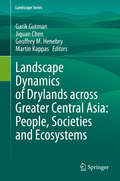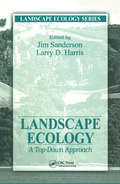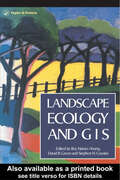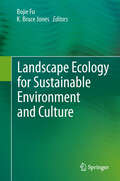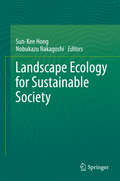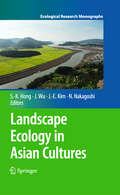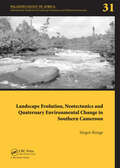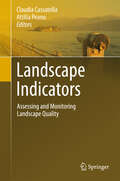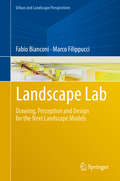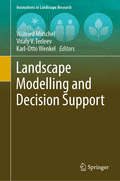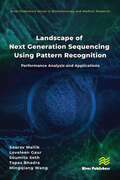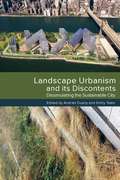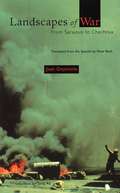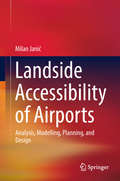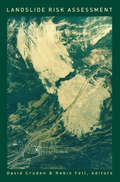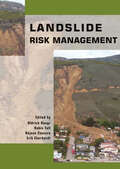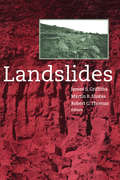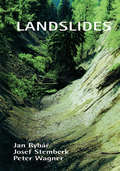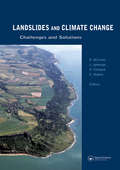- Table View
- List View
Landscape Dynamics of Drylands across Greater Central Asia: People, Societies and Ecosystems (Landscape Series #17)
by Martin Kappas Garik Gutman Jiquan Chen Geoffrey M. HenebryThis volume is a compilation of studies on interactions of changes in land cover, land use and climate with people, societies and ecosystems in drylands of Greater Central Asia. It explores the effects of collapse of socialist governance and management systems on land use in various parts of Central Asia, including former Soviet Union republics, Mongolia and northern drylands of China. Often, regional land-atmosphere feedbacks may have large global importance. Remote sensing is a primary tool in studying vast dryland territories where in situ observations are sporadic. State-of-the-art methods of satellite remote sensing combined with GIS and models are used to tackle science questions and provide an outlook of current changes at land surface and potential scenarios for the future. In 10 chapters, contributing authors cover topics such as water resources, effects of institutional changes on urban centers and agriculture, landscape dynamics, and the primary drivers of environmental changes in dryland environment. Satellite observations that have accumulated during the last five decades provide a rich time series of the dynamic land surface, enabling systematic analysis of changes in land cover and land use from space. The book is a truly international effort by a team of scientists from the U.S., Europe and Central Asia. It is directed at the broad science community including graduate students, academics and other professionals at all levels within natural and social sciences. In particular, it will appeal to geographers, environmental and social scientists, economists, agricultural scientists, and remote sensing specialists.
Landscape Ecology: A Top Down Approach (Landscape Ecology Series)
by Jim Sanderson Larry D. HarrisLandscape Ecology - a rapidly growing science - quantifies the ways ecosystems interact. It establishes links between activities in one region and repercussions in another. Landscape Ecology: A Top-Down Approach serves as a general introduction to this emerging area of study.In this book the authors take a "top down" approach. They believe that
Landscape Ecology And Geographical Information Systems
by Roy Haines-Young David R.Green Steven CousinsThe landscape we see and live in is an important part or our everyday lives, be they urban or rural. Environmental concern has grown in recent years, as a result of public awareness of the detrimental impact industry, transport and tourism can have on the ecosystem. This book examines the role of the new technologies of geographical information sys
Landscape Ecology for Sustainable Environment and Culture
by Bojie Fu Bruce Jones KClimate change and the pressures of escalating human demands on the environment have had increasing impacts on landscapes across the world. In this book, world-class scholars discuss current and pressing issues regarding the landscape, landscape ecology, social and economic development, and adaptive management. Topics include the interaction between landscapes and ecological processes, landscape modeling, the application of landscape ecology in understanding cultural landscapes, biodiversity, climate change, landscape services, landscape planning, and adaptive management to provide a comprehensive view that allows readers to form their own opinions. Professor Bojie Fu is an Academician of Chinese Academy of Sciences and Chair of scientific committee at the Research Center for Eco-Environmental Sciences, Chinese Academy of Sciences, Beijing, China. Professor K. Bruce Jones is the Executive Director for Earth and Ecosystem Sciences Division at Desert Research Institute, University of Nevada, Las Vegas, USA.
Landscape Ecology for Sustainable Society
by Sun-Kee Hong Nobukazu NakagoshiThe research category of the landscape ecology, which researches the structure, functions, and the spatio-temporal changes of the ecological landscapes, has now been contributing to the human life and the shifts of the socio-economic paradigm. Global warming has been influencing the universal life patterns of the mankind which have been maintained in the past several hundreds of years. And it has been having the influences on the international social problems and economic problems. Although the diverse plans for adapting to the climate changes have been the topics of the conservations among the ecologists internationally, it is the reality that the speed of the changes of the environment has been quicker than the time it takes to complete the solutions. In order to maintain the sustainable earth and the sustainable society, the role of the landscape ecology has been coming to the fore. Especially, the theories and the methodologies of the landscape ecology have been applied to the multidisciplinary researches by going beyond the research category of ecology, including the maximization of the efficiencies of the land spaces, the management of the ecological space (habitats) in which the biological diversity can be maintained, the utilization of the resources that are absolutely needed by the human beings (Here, it is compressed to water, energy, and food), etc. and until reaching the human society. It is considered that, to that extent, the utilizations and the applications of the landscape ecology are very much needed for the diagnoses and the evaluations of the global environmental problems which have been proceeded with rapidly in the modernity.This book is not comprised of any general remarks that explain the theories and the methods of the landscape ecology. Already, based on the basic theories of the landscape ecology, the writers have conducted the investigations on the farm villages, the cities, and the coastal ecosystems. And, through the space analyses and interpretations, the structure and functions of the landscapes were analyzed. Of course, in this book, too, the diverse ecosystems and the landscape ecological methodologies regarding the land use have been presented. However, the core of this book focuses more on what role the landscape ecology must play for the materialization of a sustainable society in the future. At the farm villages, the sustainable agriculture will be presented, and, at the cities, the discussions on the green networks and the energies will be proceeded with. Also, regarding the coasts and the seas, a thesis on the safety of the life zones of the residents adjacent to the sea and on the conservation of the island ecosystems will be presented. The sustainable society is a system that is formed by having the sustainable development as a basis. It is considered to be one aspect within a kind of a sustainable process with regard to which the natural world and the human world coexist and are in a symbiotic relationship harmoniously. In order to maintain the biodiversity, the reasonable adjustments of the human activities, like the use of the resources, are absolutely needed. Without the biological resources, the cultural diversity of the human beings, too, cannot exist. Consequentially, recently and internationally, there are a lot of the case examples that express the biocultural diversity by linking the biological diversity with the cultural diversity. In this book, the role of the landscape ecology as an academic link which can connect the two possible, if possible, is highly expected. It is, indeed, the biocultural landscape. It can be said that this concept, also, is the interconnection of the multidisciplinary spaces that must be dealt with in the modern landscape ecology. Through this book, it is intended to present a new directionality which can contribute to the sustainable society at the same time as the organization of the theories and the methods of the landscape ecology.
Landscape Ecology in Agroecosystems Management
by Lech RyszkowskiSuccessful management of agricultural landscapes depends on the recognition of the relationships between the processes and the structures that maintain the system. The rapidly growing science of Landscape Ecology quantifies the ways these ecosystems interact and establishes a link between the activities in one region and repercussions in another. A
Landscape Ecology in Asian Cultures
by Jae-Eun Kim Jianguo Wu Nobukazu Nakagoshi Sun-Kee HongCultural landscapes are a product of the interactions between humans and natural settings. They are landscapes and seascapes that are shaped by human history and land use. Socioeconomic processes especially, but also environmental changes and natural disturbances, are some of the forces that make up landscape dynamics. To understand and manage such complex landscapes, interdisciplinary and transdisciplinary approaches are necessary, emphasizing the integration of natural and social sciences and considering multiple landscape functions. The spatial patterns of Asian landscapes are strongly related to human activities and their impacts. Anthropogenic patterns and processes have created numerous traditional cultural landscapes throughout the region, and understanding them requires indigenous knowledge. Cultural landscape ecology from a uniquely Asian perspective is explored in this book, as are the management of landscapes and land-use policies. Human-dominated landscapes with long traditions, such as those described herein, provide useful information for all ecologists, not only in Asia, to better understand the human-environmental relationship and landscape sustainability.
Landscape Empowerment: A Participatory Design Approach to Create Restorative Environments for Assembly Line Workers in the Foxconn Factory
by Bin JiangThis book discusses essential strategies and approaches to creating mentally restorative environments for highly stressed and depressed workers at sweatshop factories. Drawing on the Foxconn factory in Longhua, China and an adjacent urban village as a sample site for research and design practice, the book employs a bottom-up and participatory process. The content is divided into two main parts, the first of which investigates economic, cultural, human rights, and environmental issues related to the electronic industry and urban village, providing in-depth research on various aspects, especially the working and living conditions for Foxconn workers. Based on these findings, the second part highlights potential landscape designs to address a range of issues, locations, and scales. The book’s goals are to provide a set of original methods for research and design practice in a complex social and economic context, and to raise awareness regarding the health, dignity and freedom of millions of workers.
Landscape Evolution, Neotectonics and Quaternary Environmental Change in Southern Cameroon: Palaeoecology of Africa Vol. 31, An International Yearbook of Landscape Evolution and Palaeoenvironments (Palaeoecology of Africa)
by Jürgen RungeFounded in 1966, the internationally recognized and acclaimed SeriesPalaeoecology of Africa publishes interdisciplinary scientific papers on landscape evolution and on former environments of the African continent. Beginning with topics such as changes in climate and vegetation cover, the papers expand horizons and interconnections to various typ
Landscape Fire, Smoke, and Health: Linking Biomass Burning Emissions to Human Well-Being (Geophysical Monograph Series #280)
by Tatiana V. Loboda Nancy H. F. French Robin C. PuettLandscape Fire, Smoke, and Health Linking Biomass Burning Emissions to Human Well-Being Where and when wildfires occur, what pollutants they emit, how the chemistry of smoke changes in the atmosphere, and what impact this air pollution has on human health and well-being are questions explored across different scientific disciplines. Landscape Fire, Smoke, and Health: Linking Biomass Burning Emissions to Human Well-Being is designed to create a foundational knowledge base allowing interdisciplinary teams to interact more effectively in addressing the impacts of air pollution from biomass burning on human health. Volume highlights include: Core concepts, principles, and terminology related to smoke and air quality used in different disciplines Observational and modeling tools and approaches in fire science Methods to sense, model, and map smoke in the atmosphere Impacts of biomass burning smoke on the health and well-being of children and adults Perspectives from researchers, modelers, and practitioners Case studies from different countries Information to support decision-making and policy The American Geophysical Union promotes discovery in Earth and space science for the benefit of humanity. Its publications disseminate scientific knowledge and provide resources for researchers, students, and professionals.
Landscape Indicators
by Claudia Cassatella Attilia PeanoIn recent years EU policy towards the 'landscape' has become better defined, whereas at the same time the notion of 'landscape' itself remains elusive. The need for indicators to evaluate and monitor the effects of landscape policies and plans is urgent. What is more, landscape is one of the components considered in environmental reporting, but unlike air, soil, or water, it is difficult to measure using quantitative methods. With studies on landscape indicators being as rare as they are, this volume is an attempt to fill the gap, dealing as it does with the definition and use of specific indicators for landscape assessment and monitoring. To tackle the diverse dimensions of the landscape (whose complexity is well known), the subject is approached by a multidisciplinary team of experts in landscape ecology, landscape history, landscape perception, regional planning, strategic environmental assessment and environmental impact assessment procedures, and multi-criteria assessment methods. Individual chapters include comparative assessments of studies conducted thus far in the EU, as well as detailed analyses of ecological, historical, perceptive, land-use, and economic ways of looking at landscape. As well as providing a rich source of references for researchers studying the landscape from a variety of perspectives, the book will be required reading for European officials involved at any level in planning or assessing the landscape or environment.
Landscape Indicators: Assessing and Monitoring Landscape Quality
by Claudia Cassatella Attilia PeanoIn recent years EU policy towards the ‘landscape’ has become better defined, whereas at the same time the notion of ‘landscape’ itself remains elusive. The need for indicators to evaluate and monitor the effects of landscape policies and plans is urgent. What is more, landscape is one of the components considered in environmental reporting, but unlike air, soil, or water, it is difficult to measure using quantitative methods.With studies on landscape indicators being as rare as they are, this volume is an attempt to fill the gap, dealing as it does with the definition and use of specific indicators for landscape assessment and monitoring. To tackle the diverse dimensions of the landscape (whose complexity is well known), the subject is approached by a multidisciplinary team of experts in landscape ecology, landscape history, landscape perception, regional planning, strategic environmental assessment and environmental impact assessment procedures, and multi-criteria assessment methods. Individual chapters include comparative assessments of studies conducted thus far in the EU, as well as detailed analyses of ecological, historical, perceptive, land-use, and economic ways of looking at landscape.As well as providing a rich source of references for researchers studying the landscape from a variety of perspectives, the book will be required reading for European officials involved at any level in planning or assessing the landscape or environment.
Landscape Lab: Drawing, Perception and Design for the Next Landscape Models (Urban and Landscape Perspectives #20)
by Fabio Bianconi Marco FilippucciThis book explores the relationship between the sciences of representation and the strategy of landscape valorisation. The topic is connected to the theme of the image of the city, which is extended to the territory scale and applied to case studies in Italy’s Umbria region, where the goal is to strike a dynamic balance between cultural heritage and nature. The studies demonstrate how landscape represents an interpretive process of finding meaning, a product of the relationships between mankind and the places in which it lives. The work proceeds from the assumption that it is possible to describe these connections between environment, territory and landscape by applying the Vitruvian triad, composed of Firmitas (solidity), Utilitas (utility) and Venustas(beauty). The environment, the sum of the conditions that influence all life, represents the place’s solidity, because it guarantees its survival. In turn, territory is connected to utility, and through its etymological meaning is linked to possession, to a domain; while landscape, as an “area perceived by people”, expresses the search for beauty in a given place, the process of critically interpreting a vision.
Landscape Modelling and Decision Support (Innovations in Landscape Research)
by Wilfried Mirschel Vitaly V. Terleev Karl-Otto WenkelThis book contributes to a deeper understanding of landscape and regional modelling in general, and its broad range of facets with respect to various landscape parameters. It presents model approaches for a number of ecological and socio-economic landscape indicators, and also describes spatial decision support systems (DSS), frameworks, and model-based tools, which are prerequisites for deriving sustainable decision and solution strategies for the protection of comprehensively functioning landscapes. While it mainly focuses on the latest research findings in regional modelling and DSS in Europe, it also highlights the work of scientists from Russia. The book is intended for landscape modellers, scientists from various fields of landscape research, university teaching staff, and experts in landscape planning and management, landscape conservation and landscape policy.
Landscape of Next Generation Sequencing Using Pattern Recognition: Performance Analysis and Applications (River Publishers Series in Biotechnology and Medical Research)
by Saurav Mallik Loveleen Gaur Soumita Seth Tapas Bhadra Mingqiang WangThis book focuses on an eminent technology called next generation sequencing (NGS) which has entirely changed the procedure of examining organisms and will have a great impact on biomedical research and disease diagnosis. Numerous computational challenges have been brought on by the rapid advancement of large-scale next-generation sequencing (NGS) technologies and their application. The term ""biomedical imaging"" refers to the use of a variety of imaging techniques (such as X-rays, CT scans, MRIs, ultrasounds, etc.) to get images of the interior organs of a human being for potential diagnostic, treatment planning, follow-up, and surgical purposes. In these circumstances, deep learning, a new learning method that uses multi-layered artificial neural networks (ANNs) for unsupervised, supervised, and semi-supervised learning, has attracted a lot of interest for applications to NGS and imaging, even when both of these data are used for the same group of patients.The three main research phenomena in biomedical research are disease classification, feature dimension reduction, and heterogeneity. AI approaches are used by clinical researchers to efficiently analyse extremely complicated biomedical datasets (e.g., multi-omic datasets. With the use of NGS data and biomedical imaging of various human organs, researchers may predict diseases using a variety of deep learning models. Unparalleled prospects to improve the work of radiologists, clinicians, and biomedical researchers, speed up disease detection and diagnosis, reduce treatment costs, and improve public health are presented by using deep learning models in disease prediction using NGS and biomedical imaging. This book influences a variety of critical disease data and medical images.
Landscape Urbanism and its Discontents
by Andrés Duany Emily TalenIn contemporary Western society, urban development is regarded as an unfortunate blight from which nature provides a much-needed respite. This apparent dichotomy ignores the interdependence between human settlement and the natural world. In fact, one of the most pressing problems facing urban theorists today is determining how to resolve the tension between the built and natural environments, in the process creating truly sustainable cities.Landscape Urbanism and its Discontents is a collection of essays exploring the debate over urban reform, now polarized around the two competing paradigms of Landscape Urbanism and the New Urbanism. Landscape Urbanism is conceived as a more ecologically based approach, while New Urbanism is more concerned with the built form. Well-known and influential urban theorists such as Andrés Duany and James Howard Kunstler delve into the impact of the tension between the two perspectives on:Smart growthNeighborhood designSustainable developmentCreating cities that are in balance with natureWhile there is significant overlap between Landscape Urbanism and the New Urbanism, the former has assumed prominence amongst most critical theorists, whereas the latter's proponents are more practically oriented. Given that these two sets of ideas are at the forefront of sustainable urban design, the analysis- and potential reconciliation-offered by Landscape Urbanism and its Discontents is long overdue.Andrés Duany is a leading proponent of the New Urbanism and is a founding principal at Duany Plater-Zyberk & Company.Emily Talen is a professor at Arizona State University and the author of four previous books on urban design.
Landscapes of War: From Sarajevo to Chechnya
by Juan Goytisolo Peter BushAn incisive examination of the tensions that exist between the West and Islamic societies of Europe, North Africa, and the Middle East. Provides rich historical analysis and reportage of life in four explosive war-zones: Sarajevo, Algeria, the West Bank and Gaza, and Chechnya. Translated by Peter Bush.
Landscaping Earth Ponds
by Tim MatsonThe guru of earth ponds explains how to site, design, shape, and plant these beloved fixtures of rural landscapes-and make them fit your property and your life. In the decades since he wrote his acclaimed "Earth Ponds," Tim Matson has designed scores of ponds, each unique to its site and its owners. In "Landscaping Earth Ponds," he shares what he has learned to make these captivating ponds truly fit into their landscapes and into the lives and lifestyles of their owners. Ponds have long been valued for their charm and utility: how else can you simultaneously enliven your landscape, create recreational opportunities, help the environment, and increase your property value? Earth ponds are increasingly recognized for the full range of gardening, landscaping, and ecological promise they hold. As pond-building methods have been perfected, more homeowners are restoring existing ponds or digging new ones. With dozens of color photographs, Matson shows you how to site a pond in right relation to your house, offering surprisingly simple ways to visually link the two. His proven methods and designs reflect the many moods water evokes. Screen your pond for privacy, create a sandy beach and natural diving platform, encourage wetland gardens, line the shores with moisture-loving perennials, or design your gardens and paths to create a sense of mystery and adventure.
Landside Accessibility of Airports: Analysis, Modelling, Planning, And Design
by Milan JanićThis book covers the analysis, modelling, planning, and design of airport landside access modes and their systems. It elaborates on the issues and related problems of airport landside accessibility in an innovative, comprehensive and systematic way. In addition to the general concept of accessibility, the book addresses the analysis and modelling of infrastructure-related, technological, operational, economic, social and environmental performance of road- and rail-based transport systems, as well as the core principles of their planning and design. The book provides guidelines on the modelling, planning, and design of airport landside access modes and their systems, which will contribute to the overall sustainable development of airports. Its main features are: presents a multidimensional examination of performance for specific airport landside access modes and their systems; pursues a qualitative and quantitative approach to developing performance indicators for estimating the sustainability of airport landside access modes and their systems; includes illustrative cases of airport landside accessibility, and numerical examples as exercises for assessing performance using the systems’ indicators. As such, the book offers a valuable source of information for all practitioners involved in analysing, planning and designing more environmentally friendly airport access modes and systems, and who want to learn how to overcome the issues and problems surrounding landside accessibility. It will also benefit students studying the analysis and modelling of transportation systems, and researchers seeking to promote improved sustainability at airports.
Landside | Airside: Why Airports Are the Way They Are
by Victor MarquezWhy do we love and hate airports at the same time? Have you been a victim of tiresome walks, congestion, long lines, invasive pat-downs, eternal delays and so on? Perhaps no other technological system has been challenged by continuously changing paradigms like airports. Think a minute on rail stations; think of how successful are the rail networks of the world in connecting nations, with just minimum security measures. Why aviation and airports are so radically different in this regard?In order to answer those questions the author embarks on a thorough revision of airport history and airport planning that in the end builds up a new theory about how airports are formed from the outset. Within its journey from the early airfield to the newest hubs of today, Dr. Marquez identifies for the first time the Landside–Airside boundary as the single most important feature that shapes an airport. In this sense, his finding challenges the “historical linearity” that, until today, used to explain a century of airports.From both an analytical and theoretical S&TS stance, Dr. Marquez assures that it is only when airports needed to be fully reinvented (LaGuardia, Dulles and Tampa) when they become transparent and we may be able to understand their lack of technological stability.
Landslide Risk Assessment
by Robin Fell David M. CrudenThe 25 papers collected together in this volume present comprehensive coverage of all major aspects of landslide risk assessment, including the risk assessment framework, and methods for estimating probability of landsliding vulnerability and risk.
Landslide Risk Management
by Oldrich Hungr Robin Fell Réjean Couture Erik EberhardtLandslide Risk Management comprises the proceedings of the International Conference on Landslide Risk Management, held in Vancouver, Canada, from May 31 to June 3, 2005. The first part of the book contains state-of-the-art and invited lectures, prepared by teams of authors selected for their experience in specific topics assigned to them by the JTC
Landslides: Proceedings of the 9th international conference and field trip, Bristol, 16 September 1999
by James S. Griffiths Martin R. Stokes Robert G. ThomasThis text gives an overview of the main landslide field sites. It covers aspects of recent landslide research at the University of Wollongong.Topics: An overview of the main landslide field sites in the 9th ICFL; Aspects of recent landslide research at the University of Wollongong; Infiltration of rainwater and slope failure; Landslide hazards and highway engineering in Central and Northern Jordan; El Niño 1997-98: Direct costs of damaging landslides in the San Francisco Bay region; Mass movement features in the vincinity of the town Sorbas, South-east Spain; The movements and the countermeasures of the Choja Landslide; Interest in landslide hazard information - Parallels between Kingston, Jamaica and the San Francisco Bay region, USA; Slide activity in quick clay related to pore water pressure and weather parameters; Old and recent landslides of Barranco de Tirajana basin, Gran Canaria, Spain.
Landslides: Proceedings of the First European Conference on Landslides, Prague, Czech Republic, 24-26 June 2002
by Peter Wagner Jan Rybář Josef StemberkThe proceedings contain five invited lectures and 99 papers relevant to landslide occurrence and problems from Europe, Asia, America, Africa and Australia and New Zealand. The five special invited lectures deal with a variety of important aspects of landslides.
Landslides and Climate Change: Proceedings of the International Conference on Landslides and Climate Change, Ventnor, Isle of Wight, UK, 21-24 May 2007
by R. McInnes J. Jakeways H. Fairbank E. MathieInvestigates the relationship between landslides and climate change. Considers proactive approaches to hazard and risk management, combining geohazard modelling and prediction with effective risk management and informed planning policy, as a means of safeguarding the sustainability of communities at risk.
